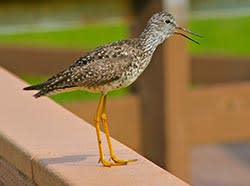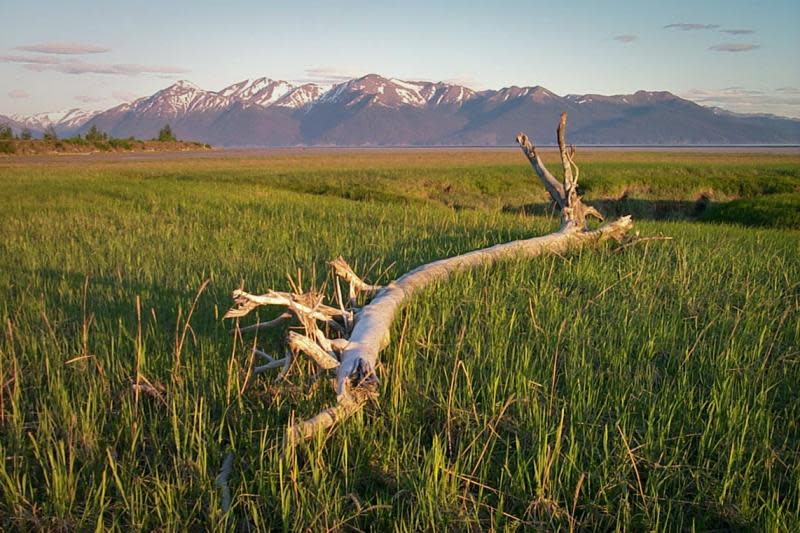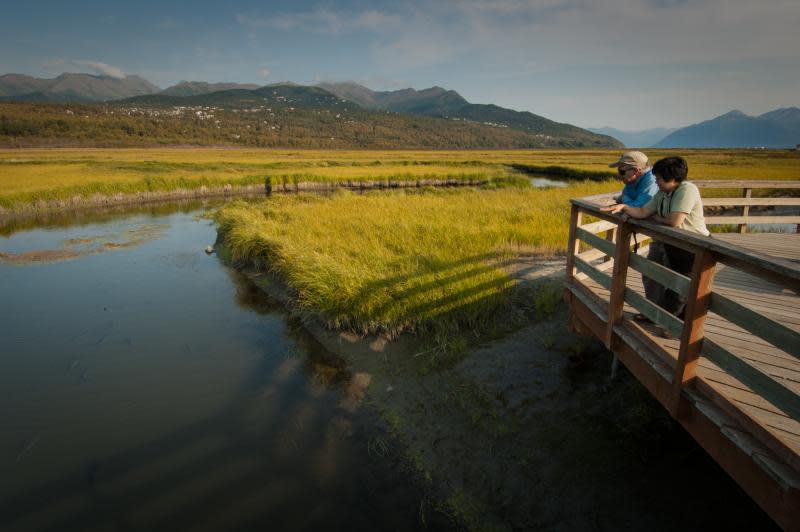
Potter Marsh
About
GENERAL INFORMATION
Criteria:
- Listed on more than one “valuable wetland” list by natural resource agencies or nongovernment organizations.
- Protects biological diverse wetland flora, fauna and/or their habitat
- Supports significant numbers of wetland-dependent fauna, such as water birds or fish
Potter Marsh, at the southern end of the Anchorage Coastal Wildlife Refuge, is an ideal break from Anchorage for birders and other wildlife viewers. From the Seward Highway just before the left turn into the Potter Marsh parking lot, you are treated to a stunning view of Turnagain Arm. A wooden boardwalk winds 1,550 feet from the parking area through the marsh and across watery openings and sedges, perfect habitat for a rich variety of birds.
From late April through September, Canada geese, northern pintails, canvasback ducks, red-necked phalaropes, horned and red-necked grebes, and northern harriers use this wetland. Look for eagle nests in the cottonwoods near the base of the bluff using binoculars or a spotting scope. Eagles have a sharp sense of sight and can see at least four times better than people, enabling them to detect movements of small animals like hares from a mile away. When eagles soar overhead, they are scanning open areas for prey.
From May to August, gulls, Arctic terns, shorebirds such as yellowlegs, and occasionally trumpeter swans are present during spring and fall migration. In addition to birds, look for slow movement and a v-shaped wake in the waters of the marsh, signs of muskrats swimming past. Their small brownish heads peek just above the water as they meander in and out of the wetland's open areas.
Moose also frequent the marsh year-round. May and June are good times to see these large ungulates standing in the marsh foraging for new growth.
About halfway along the boardwalk, Rabbit Creek flows underneath and provides a good spot to see spawning chinook, coho, or humpback salmon from May to August, depending on the species. Spot their bright red bodies swimming in the creek.
Exemplary Ecosystem Services:
- Maintains ecological connectivity/cohesion
- Aesthetic/cultural heritage value/ provisioning
- Recreation (birdwatching, ecotourism)
- Storm abatement
- Flood storage/mitigation
- Carbon storage
- Water quality improvement
- Education
CONSERVATION STATUS AND THREATS
Public Access: Yes
Current and Future Threats: Invasive plants on periphery
Conservation status: State/Province/Regional Protection
Adjacent Land Use: Residential - medium density
Approximate natural buffer width:
50-100 ft
ECOLOGY
Approximate size: 564 acres
General wetland characterization:
Coastal Shallow Fresh Marsh
Coastal Open Fresh Water
Coastal Salt Meadow
Coastal Regularly Flooded Salt Marsh
Adjacent Water Bod(ies):
Stream
Tidal Systems
Name of body of water: Turnagain Arm and Rabbit Creek
Surficial Geology:
Glaciers and tides were the major natural forces that shaped the land that became Potter Marsh. The silt and sand that covers the area is primarily of glacial origin, deposited by ocean currents and tides. The coastal bluffs above the marsh consist of colluvium —chiefly gravel, with some sand, silt, and clay. Several outcrops of bedrock define the eastern edge of Potter Marsh. In the northern part of the marsh the gravel alluvial fans of Rabbit and Little Rabbit creeks are dominant features (MOA, 1980). The Municipality of Anchorage designated an andesitic dike, located just east of Potter Marsh along the Old Seward Highway, as an Area Meriting Special Attention (AMSA). The dike, which shows andesitic lithology, weathering, and joint patterns, is the only known igneous exposure in the municipality. The feature is described as: (1) an area of unique, scarce, fragile, and vulnerable natural habitat, physical features, and scenic importance; (2) an area of unique geologic significance, that is susceptible to industrial or commercial development; and (3) an area with special scientific values and opportunities (MOA, 2006).
If Adjacent to Stream, stream order: first order stream
Soils:
Glacial silt is the dominant surficial deposit underlying Potter Marsh (Walsh & Tankersley, 1998). The soil in Potter Marsh is Salamatof peat, a poorly drained soil 63 inches thick consisting of fibrous peat material composed of dark reddish-brown, coarse sphagnum moss and sedge fibers (SCS, 1979; MOA, 1980). The soil is saturated most of the time (SCS, 1979) and increases in organic content with distance from the railroad embankment (Ross, 1964). The outwash plains of Rabbit and Little Rabbit creeks are composed of Moose and Chena river silt loams, poorly drained soils that are frequently flooded for brief periods (SCS, 1979; MOA, 1980)
FLORA AND FAUNA
Dominant flora: bluejoint and sedges
Unique flora: marsh arrowgrass and common marestail, sedges
Dominant fauna: gulls, terns, yellowlegs, salmon, tundra swans, trumpeter swans, pintails, moose, wood frog
ADDITIONAL INFORMATION:
Potter Marsh Master Interpretive Plan
CONTACT INFORMATION
Applicant First Name: Emily
Applicant Last Name: Creely
Phone: 907-602-0185
Applicant E-mail Address: ecreely@dowl.com
Images


